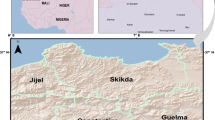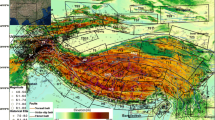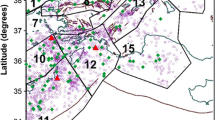Abstract
The Bayesian probability estimation seems to have efficiencies that make it suitable for calculating different parameters of seismicity. Generally this method is able to combine prior information on seismicity while at the same time including statistical uncertainty associated with the estimation of the parameters used to quantify seismicity, in addition to the probabilistic uncertainties associated with the inherent randomness of earthquake occurrence. In this article a time-independent Bayesian approach, which yields the probability that a certain cut-off magnitude will be exceeded at certain time intervals is examined for the region of Alborz, Iran, in order to consider the following consequences for the city of Tehran. This area is located within the Alpine-Himalayan active mountain belt. Many active faults affect the Alborz, most of which are parallel to the range and accommodate the present day oblique convergence across it. Tehran, the capital of Iran, with millions of inhabitants is located near the foothills of the southern Central Alborz. This region has been affected several times by historical and recent earthquakes that confirm the importance of seismic hazard assessment through it. As the first step in this study an updated earthquake catalog is compiled for the Alborz. Then, by assuming a Poisson distribution for the number of earthquakes which occur at a certain time interval, the probabilistic earthquake occurrence is computed by the Bayesian approach. The highest probabilities are found for zone AA and the lowest probabilities for zones KD and CA, meanwhile the overall probability is high.














Similar content being viewed by others
References
Adeli H, Nemat-Nasser S (1977) A probabilistic seismic investigation for Iran: data analysis and preliminary results. Tech. Rep. 77-8-1. Northwestern University
Akasheh B, Berckhemer H (1984) Focal mechanisms of earthquakes of Iran with special emphasis on small shocks in Tehran region. N Jb Paleont Abh 168:244–255
Allen MB, Ghassemi MR, Shahrabi M, Qorashi M (2003) Accommodation of late Cenozoic oblique shortening in the Alborz range, northern Iran. J Struct Geol 25:659–627
Allen MB, Jackson J, Walker R (2004) Late Cenozoic reorganization of the Arabia-Eurasia collision and the comparison of short-term and long-term deformation rates. Tectonics 23:TC2008
Ambraseys NN (1964) Historical seismicity of the North Central Iran. Rep. No. 29, Geological Survey of Iran
Ambraseys NN (1976) The relocation of epicenters in Iran. Geophys J R Astr Soc 53:117–121
Ambraseys NN (2001) Reassessment of earthquakes, 1990–1999, in the eastern Mediterranean and Middle East. Geophys J Int 145:471–485
Ambraseys NN, Melville CP (1982) A history of Persian earthquakes. Cambridge University Press, UK
Ahmadi G, Nowroozi AA (1981) Earthquake risk analysis of Iran II: probabilistic seismic risk for various magnitudes. J Earth Space Phys 9:1–19
Ahmadi G, Mostaghel N, Nowroozi AA (1989) Probabilistic seismic risk for various peak ground accelerations. Iran J Sci Technol 13:115–156
Ashtari M, Hatzfeld D, Kamalian N (2005) Microseismicity in the region of Tehran. Tectonophysics 395:193–208
Asudeh I (1983) ISC mislocation of earthquakes in Iran and geometrical residuals. Tectonophysics 95:61–74
Axen GJ, Lam PS, Grove M, Stockli DF, Hassanzadeh J (2001) Exhumation of the west-central Alborz Mountains, Iran, Caspian subsidence, and collision-related tectonics. Geology 29:559–562
Benjamin JR (1968) Probabilistic models for seismic force design. J Struct Div ASCE 94(ST5):1175–1196
Berberian M (1976) Contribution to the seismotectonic of Iran, Part II. Rep. No. 39, Geological Survey of Iran
Berberian M (1979) Evaluation of the instrumental and relocated epicenters of Iranian earthquakes. Geophys J R Astr Soc 58:625–630
Berberian M (1994) Natural hazards and the first earthquake catalogue of Iran. IIEES, Iran
Berberian M, Yeats RS (1999) Patterns of historical earthquake rupture in the Iranian Plateau. Bull Seismol Soc Am 89:120–139
Berberian M, Yeats RS (2001) Contribution of archaeological data to studies of earthquake history in the Iranian Plateau. J Struct Geol 23:563–584
Berberian M, Qoreyshi M, Jackson JA, Priestly K, Wallace TC (1992) The Rudbar-Tarom earthquake of 20 June 1990 in NW Persia: preliminary field and seismological observations and its tectonic significance. Bull Seismol Soc Am 82:1726–1775
Berberian M, Qorashi M, Mohajer A, Shojataheri J (1993) Seismotectonics and earthquake fault hazard investigations in the Tehran region. Rep. No. 56, Geological Survey of Iran
Bozorgnia Y, Mohajer-Ashjai A (1982) Seismic risk investigation of major cities of Iran. J Earth Space Phys 11:15–38
Burton PW (1979) Seismic risk in southern Europe through to India examined using Gumbel’s third distribution of extreme values. Geophys J R Astr Soc 59:249–280
Campbell KW (1982) Bayesian analysis of extreme earthquake occurrences: part I. Probabilistic hazard model. Bull Seismol Soc Am 72:1689–1705
Campbell KW (1983) Bayesian analysis of extreme earthquake occurrences: part II. Probabilistic hazard model. Bull Seismol Soc Am 73:1099–1115
De Martini PM, Hessami K, Pantosti D, D’Addezio G, Alinaghi H (1998) The geologic contribution to the evaluation of the seismic potential of the Kahrizak fault (Tehran, IRAN). Tectonophysics 287:187–199
Engdahl ER, Ven der Hilst R, Buland R (1998) Global teleseismic earthquake relocation with improved travel times and procedures for depth determination. Bull Seismol Soc Am 88:722–743
Engdahl ER, Bergman EA, Myers SC, Ryall F (2004) Improved ground truth in southern Asia using in-country data, analyst waveform review and advanced algorithms. In: Proceedings of the 26th seismic research review: trends in nuclear explosion monitoring. Orlando, FL, pp 257–266, September 2004
Esteva L (1969) Seismicity prediction: Bayesian approach. In: Proceedings of the 4th world conference on earthquake engineering. Santiago, Chile, pp 172–184
Gao L, Wallace TC (1995) The 1990 Rudbar-Tarom Iranian earthquake sequence: evidence for slip partitioning. J Geophys Res 100:15317–15332
GSI: Geological maps of Alborz, Tehran, Iran
Gumbel EJ (1958) Statistics of extremes. Columbia University Press, New York
Harvard University: CMT catalogue. http://www.seismology.harvard.edu/CMTsearch.html
Hedayati A, Brander JL, Berberian M (1976) Microearthquake survey of Tehran region Iran. Bull Seismol Soc Am 66:1713–1725
IGTU: Alborz-Central Iran fault map (published as a part of Tehran province seismic hazard assessment project). Tehran, Iran
IIEES: Major active faults of Iran. Tehran, Iran
ISC: On-line Bulletin. Thatcham, UK. http://www.isc.ac.uk
Jackson J, Priestly K, Allen M, Berberian M (2002) Active tectonics of the south Caspian Basin. Geophys J Int 148:214–245
Kijko A (1984) Is it necessary to construct empirical distributions of maximum earthquake magnitudes? Bull Seismol Soc Am 74:339–347
Lamarre M, Townshed B, Shah HC (1992) Application of the bootstrap method to quantify uncertainty in seismic hazard estimates. Bull Seismol Soc Am 82:104–119
Lomnitz C (1974) Global tectonics and earthquake risk. Elsevier, Amsterdam
Makropoulos KC, Burton PW (1985) Seismic hazard in Greece: II ground acceleration. Tectonophysics 117:259–294
Mason F, Chery J, Hatzfeld D, Martinod J, Vernant P, Tavakoli F, Ghafory-Ashtiani M (2005) Seismic versus aseismic deformation in Iran inferred from earthquakes and geodetic data. Geophys J Int 160:217–226
Mirzaei N, Gao M, Chen Y-T (1997) Seismicity in major seismotectonic provinces of Iran. Earthquake Res China 11:351–361
Mirzaei N, Gao M, Chen Y-T (1998) Seismic source regionalization for seismic zoning of Iran: major seismotectonic Provinces. J Earthquake Pred Res 7:465–495
Mortgat CP, Shah HC (1979) A Bayesian model for seismic hazard mapping. Bull Seismol Soc Am 69:1237–1251
Neghabat F, Liu SC (1977) Earthquake regionalization of Iran. In: Proceedings of the 7th world conference earthquake engineering. Delhi, pp 536–551
Nowroozi AA (1971) Seismotectonics of the Persian plateau, eastern Turkey, Caucasus and Hindu-kush regions. Bull Seismol Soc Am 61:317–341
Nowroozi AA (1976) Seismotectonic provinces of Iran. Bull Seismol Soc Am 66:1249–1276
Nowroozi AA, Ahmadi G (1986) Analysis of earthquake risk I Iran based on seismotectonic provinces. Tectonophysics 122:89–114
Papadopoulos GA (1987) An alternative view of the Bayesian probabilistic prediction of strong shocks in the Hellenic arc. Tectonophysics 132:311–320
Papoulia J, Stavrakakis G, Papanikolaou D (2001) Bayesian estimation of strong earthquakes in the inner Messiniakos fault zone southern Greece base on seismological and geological data. J Seismol 5:233–242
Pisarenko VF, Lyubushin AA (1997) Statistical estimation of maximal peak ground acceleration at a given point of seismic region. J Seismol 1:395–405
Reasenberg PA (1985) Second order moment of central California seismicity 1969–82. J Geophys Res 90:5479–5495
Ritz JF, Ghassemi A, Salamati R, Shafei A, Solaymani S, Vernant P (2006) Active transtension inside central Alborz: a new insight into northern Iran-southern Caspian geodynamics. Geology 34:477–480
Rowshandel B, Nemat-Nasser S, Adeli H (1979) A tentative study of seismic risk in Iran. Iran J Sci Tech 7:211–241
Rowshandel B, Nemat-Nasser S, Corotis RB (1981) A comparative seismic hazard study for Azarbaidjan province of Iran. Bull Seismol Soc Am 71:335–362
Shoja-Taheri J, Niazi M (1981) Seismicity of the Iranian plateau and bordering regions. Bull Seismol Soc Am 71:477–489
Stavrakakis GN, Drakopoulos J (1995) Bayesian probabilities of earthquake occurrence in Greece and surrounding areas. Pure Appl Geophys 144:307–319
Stocklin J (1968) Structural history and tectonics of Iran, a review. Bull Am Assoc Petrol Geol 52:1229–1258
Stocklin J (1974) Northern Iran: Alborz Mountain, Mesozoic-Cenozoic orogenic Belt, data for orogenic studies. Geol Soc Lond 4:213–234
Takin M (1972) Iranian geology and continental drift in the Middle East. Nature 235:147–150
Tavakoli B (1996) Major seismotectonic provinces of Iran. IIEES report
Tsapanos TM, Papadopoulos GA, Galanis OCh (2003) Time independent seismic hazard analysis of Greece deduced from Bayesian statistics. Nat Hazards Earth Syst Sci 3:129–134
Vernant P, Nilforoushan F, Chery J, Bayer R, Djamour Y, Masson F, Nankali H, Ritz JF, Sedighi M, Tavakoli F (2004) Deciphering oblique shortening of Central Alborz in Iran using geodetic data. Earth Planet Sci Lett 223:177–185
Yegulalp T, Kuo JT (1974) Statistical prediction of occurrence of maximum magnitude earthquakes. Bull Seismol Soc Am 64:393–414
Author information
Authors and Affiliations
Corresponding author
Rights and permissions
About this article
Cite this article
Ashtari Jafari, M. Time independent seismic hazard analysis in Alborz and surrounding area. Nat Hazards 42, 237–252 (2007). https://doi.org/10.1007/s11069-006-9097-7
Received:
Accepted:
Published:
Issue Date:
DOI: https://doi.org/10.1007/s11069-006-9097-7




